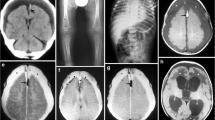Abstract
Background
Abusive head trauma (AHT) is a common condition in children. Little is known in this condition regarding the frequency of seizures, the factors associated with increased risk of seizures, or the association of seizures with outcome. We sought to determine frequency and risks for in-hospital seizures after AHT.
Methods
This was a single-center, retrospective chart review study at a 270 bed tertiary care referral pediatric hospital.
Results
A total of 54 cases of AHT were identified during the study period. During the first week following hospital admission, 33% of patients were observed to have clinical seizures. The occurrence of clinical seizures after admission was associated with findings on initial CT including midline shift, cerebral edema, and loss of gray white differentiation. MRI findings associated with clinical seizures after admission included midline shift, cerebral edema, infarction, and restricted diffusion. The presenting complaint of seizures or acute mental status changes well as a variety of abnormal imaging findings including gray white blurring, infarction, and edema were associated with short-term outcomes.
Conclusions
Specific neuroradiologic findings identify children at greater risk for seizures, both clinical and subclinical, following AHT. Clinical and subclinical seizures are common in the initial hospitalization for AHT.
Similar content being viewed by others
References
Keenan H, Runyan D, Marshall S, Nocera M, Merten D, Sinal S. A population-based study of inflicted traumatic brain injury in young children. JAMA. 2003;290:621–6.
Gerber P, Coffman K. Nonaccidental head trauma in infants. Childs Nerv Syst. 2007;23:507–4999.
Barlow K, Thomson E, Johnson D, Minns R. Late neurologic and cognitive sequelae of inflicted traumatic brain injury in infancy. Pediatrics. 2005;116:174–85.
Shaken baby syndrome (2001) Accessed March 10, 2010, http://www.health.state.ny.us/nysdoh/consumer/sbs/definition.htm
Chiesa A, Duhaime A. Abusive head trauma. Pediatr Clin N Am. 2009;56:331–7.
Ettaro L, Berger R, Songer T. Abusive head trauma in young children: characteristics and medical charges in a hospitalized population. Child Abuse Negl. 2004;28:1099–111.
Bourgeois M, Di Rocco F, Garnett M, et al. Epilepsy associated with shaken baby syndrome. Childs Nerv Syst. 2008;24:169–72.
Barlow K, Spowart J, Minns R. Early posttraumatic seizures in non-accidental head injury: relation to outcome. Dev Med Child Neurol. 2000;42:591–4.
Garcia P. Nonconvulsive seizures in the pediatric intensive care unit: out of sight, out of mind? Epilepsy Curr. 2007;7:70–2.
Claassen J, Mayer S, Kowalski R, Emerson R, Hirsch L. Detection of electrographic seizures with continuous EEG monitoring in critically ill patients. Neurology. 2004;62:1743–8.
Hymel K, Makoroff K, Laskey A, Conaway M, Blackman J. Mechanisms, clinical presentations, injuries, and outcomes from inflicted versus noninflicted head trauma during infancy: results of a prospective, multicentered, comparative study. Pediatrics. 2007;119:922–9.
Fujiwara T, Okuyama M, Miyasaka M. Characteristics that distinguish abusive from nonabusive head trauma among young children who underwent computed head tomography in Japan. Pediatrics. 2008;122:841–7.
Keenan H, Runyan D, Marshall S, Nocera M. A population-based comparison of clinical and outcome characteristics of young children with serious inflicted and noninflicted traumatic brain injury. Pediatrics. 2004;114:633–9.
Bechtel K, Stoessel K, Leventhal J, et al. Characteristics that distinguish accidental from abusive injury in hospitalized young children with head trauma. Pediatrics. 2004;114:165–8.
Christian C, Block R, Committee on Child Abuse and Neglect; American Academy of Pediatrics. Abusive head trauma in infants and children. Pediatrics. 2009;123:1409–11.
Case M, Graham M. Position paper on fatal abusive head injuries in infants and young children. Am J Forensic Med Pathol. 2001;22:112–22.
Bonnier C, Nassogne M, Saint-Martin C, Mesples B, Sebire G. Neuroimaging of intraparenchymal lesions predicts outcome in shaken baby syndrome. Pediatrics. 2003;112:808–14.
Ewing-Cobbs L, Prasad M, Kramer L, Louis P, Fletcher JBJ, Alpert B. Acute neuroradiologic findings in young children with inflicted or noninflicted traumatic brain injury. Childs Nerv Syst. 2000;16:25–33.
Hedlund G, Frasier L. Neuroimaging of abusive head trauma. Forensic Sci Med Pathol. 2009;5:280–90.
Tung G, Kumar K, Richardson R, Jenny C, Brown W. Comparison of accidental and nonaccidental traumatic head injury in children on noncontrast computed tomography. Pediatrics. 2006;118:626–33.
Jirsch J, Hirsch L. Nonconvulsive seizures: developing a rational approach to the diagnosis and management in the critically ill population. Clin Neurophysiol. 2007;118:1660–70.
Jette N, Claassen J, Emerson R, Hirsch L. Frequency and predictors of nonconvulsive seizures during continuous electroencephalographic monitoring in critically ill children. Arch Neurol. 2006;63:1750–5.
Maguire S, Pickerd N, Farewell D, Mann M, Tempest V, Kemp A. Which clinical features distinguish inflicted from non-inflicted brain injury? A systematic review. Arch Dis Child. 2009;94:860–7.
Fernando S, Obaldo R, Walsh I, Lowe L. Neuroimaging of nonaccidental head trauma: pitfalls and controversies. Pediatr Radiol. 2008;38:827–38.
Duhaime A, Durham S. Traumatic brain injury in infants: the phenomenon of subdural hemorrhage with hemispheric hypodensity (“Big Black Brain”). Prog Brain Res. 2007;161:293–302.
Jayawant S, Parr J. Outcome following subdural hemorrhages in infancy. Arch Dis Child. 2007;92:343–7.
Ewing-Cobbs L, Prasad M, Kramer L, Landry S. Inflicted traumatic brain injury: relationship of developmental outcome to severity of injury. Pediatr Neurosurg. 1999;31:251–8.
King J, MacKay M, Sirnick A, Canadian Shaken Baby Study Group. Shaken baby syndrome in Canada: clinical characteristics and outcome of hospital cases. CMAJ. 2003;168:155–9.
Claassen J, Hirsch L, Emerson R, Thompson T, Mayer S. Continuous EEG monitoring and midazolam infusion for refractory nonconvulsive status epilepticus. Neurology. 2001;57:1036–42.
Saengpattrachai M, Sharma R, Hunjan A, et al. Nonconvulsive seizures in the pediatric intensive care unit: pediatric intensive care unit: etiology, EEG, and brain imaging findings. Epilepsia. 2006;47:1510–8.
Acknowledgments
This study was supported by Davee Foundation (JG, MSW), the Lyndsey Whittingham Foundation (MSW), and the Medical Research Junior Board Foundation (MSW).
Author information
Authors and Affiliations
Corresponding author
Rights and permissions
About this article
Cite this article
Goldstein, J.L., Leonhardt, D., Kmytyuk, N. et al. Abnormal Neuroimaging is Associated with Early In-Hospital Seizures in Pediatric Abusive Head Trauma. Neurocrit Care 15, 63–69 (2011). https://doi.org/10.1007/s12028-010-9468-5
Published:
Issue Date:
DOI: https://doi.org/10.1007/s12028-010-9468-5




